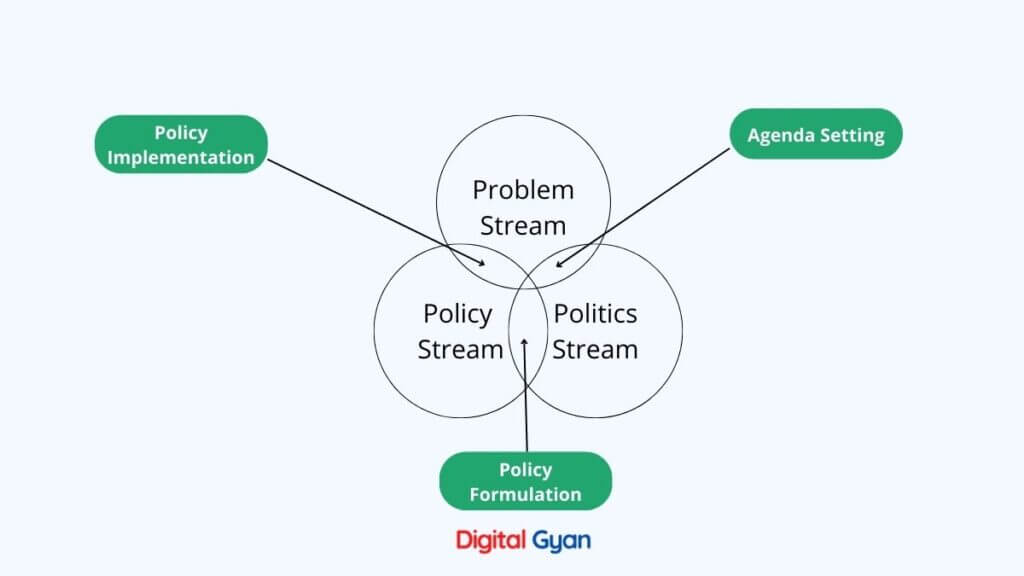What is Kingdon’s Multiple Streams Approach?
During decision-making in politics, understanding the processes involved is of utmost importance. One influential framework that provides valuable insights into this complex phenomenon is Kingdon’s Multiple Streams Approach. This approach offers a systematic way to analyse how problems, policy proposals, and political dynamics converge to shape policy change.
In this article, we will explore the key components of Kingdon’s multiple streams approach and examine its real-life applications.
What is Kingdon’s Multiple Streams Approach?
Kingdon’s Multiple Streams Approach (MSA) or multiple streams framework is a political science theory that attempts to explain how public policy is created. The theory posits three streams of activity in the policy process: the problem stream, the policy stream, and the political stream. These streams come together in a “window of opportunity” to create policy change.
The problem stream consists of the issues that the public is concerned about. The policy stream consists of the proposed ideas and solutions to address the problems. The politics stream consists of the power struggles and horse-trading that take place to get the policy enacted. The three streams come together in a “window of opportunity” when the problem is high on the public’s agenda, the policy solution is politically feasible, and there is a favourable political environment. When all three of these factors align, policy change is possible.
The MSA for policy analysis is one of the most useful theories for researching and understanding various issues related to the topic of politics. Kingdon’s Multiple Streams Approach is useful to understand why some problems never seem to be addressed and why some solutions are never enacted. By understanding the three activity streams, we can better see how policy change happens (or doesn’t happen) in our society.
Since the release of his book Agendas, Alternatives and Public Policies in 1984, the Multiple Streams Approach of John Kingdon has been frequently utilised. Intriguingly, this agenda-setting approach is so popular in comparative policy analysis, given that the book focuses primarily on the United States.
Kingdon’s multiple streams arose from the desire to understand the often murky, messy policymaking process that is often fraught with conflicting interests and perceptions among various actors, which was not achieved by traditional models that depicted this process as being linear, coherent, and systematic, usually by rational and consensual power groups.
This model allows us to view the policymaking process in its conflicting internal environment, examine its problematised problems, and consider the interests and actions of different players, the context in which policymaking occurs, and how actions are dictated.
Policymaking is divided into three major streams—where streams are viewed as differentiated and clustered with similarly minded groups of actors and interests. These streams include the problem, policy, and political streams.
According to Kingdon, these streams flow independently most of the time. However, a “policy window” can open up when all three streams converge. This happens when a recognised problem aligns with a feasible policy solution in a favourable political climate. This convergence is what creates the opportunity for an issue to be seriously considered and acted upon.

1. The Problem Stream
The problem stream represents the set of issues that policymakers and stakeholders perceive as needing attention. It consists of three main components: problem recognition, problem definition, and problem prioritization. Problem recognition is influenced by various factors such as societal trends, events in the external environment, and policy-oriented research.
The problem stream is where the problems that need policy addressed are framed to make them palatable for policy action. Many actors often contested the process’s definition, scope, and perspective. Only a minuscule fraction of problems reach the attention of policymakers. Attention is a huge accomplishment that requires prompt action, should it be diverted away.
For example, the problem of climate change gained significant recognition due to scientific evidence highlighting its potential catastrophic consequences. This recognition led to increased focus on formulating policies to address this urgent issue.
There are also multiple ways in which these issues are highlighted – including through surveys, research, processing of indicator data, and formal and informal feedback, among others. Interpretation of data is often a central tenet in the policy stream, and problems often need strong actors to push them to the priority of policymakers through various deliberate actions that compel policymakers to give attention.
2. The Policy Stream
The policy stream refers to the process of policy proposal development and presentation. It includes the identification of potential solutions, analysis of policy alternatives, and the formulation of concrete proposals. These policy proposals are developed by experts, think tanks, and interest groups. They are often influenced by research findings, pilot projects, international practices, and public input.
For instance, policy proposals to improve access to healthcare may emerge from studies demonstrating disparities in healthcare outcomes, public demand for affordable services, and successful healthcare policies implemented elsewhere.
In the policy stream, a shortlist of alternatives is generally created based on the criteria already reviewed in the preceding paragraph, and ideas with well-worked available options often have higher odds of being adopted. Policies and ideas fit well with the dominant values; those with acceptable budgetary constraints, more increased familiarity and sufficient detail often rise to the top of the shortlist. While many alternatives are commonly available, their feasibility dictates those actually available for consideration and action.
3. The Political Stream
The political stream is dictated by factors such as the ideological perspective of the administration of the day, election results, campaigns by lobby groups and the prevailing political climate. Often, questions of jurisdiction arise on different policies, with different levels of governments unable to agree on whose docket a given policy falls fully.
The politics stream represents the political landscape within which decision-making occurs. It encompasses the interests, power dynamics, and resources of key actors in the policy process. These actors include policymakers, interest groups, political parties, and the general public. The politics stream heavily influences whether a problem gains attention and whether a particular policy proposal is considered feasible or desirable.
Public opinion often plays a crucial role in shaping the political stream. For example, increased public awareness and demand for stricter gun control measures can significantly impact the political discussions and decision-making around this sensitive issue.
The Convergence of Streams
Kingdon’s approach emphasizes the importance of the convergence of the problem, policy, and political streams for policy change to occur. This convergence is often facilitated by “windows of opportunity,” which can be defined as favourable conditions or moments when policymakers are more receptive to change.
When these streams align, policy change becomes more likely. For instance, a significant societal event, such as a financial crisis or a natural disaster, can create a window of opportunity for policymakers to introduce and implement new policies to address the problem at hand.
Real-life Applications of Kingdon’s Multiple Framework
Various policy decisions have been influenced by Kingdon’s approach, demonstrating its practical value. For example, the passage of the Affordable Care Act in the United States involved the convergence of problem recognition (rising healthcare costs and lack of coverage), policy proposals (development of affordable healthcare options), and political dynamics (changes in the political landscape and public demand for healthcare reform).
However, implementing the multiple streams approach in practice is not without its challenges. The model has been criticised for oversimplifying the complexities of decision-making and neglecting the role of power dynamics and partisan interests. Also, identifying the right opportunities for policy change and effectively communicating policy proposals remain significant hurdles.
Conclusion
Kingdon’s Multiple Streams Approach is a policy making or development model that suggests various ways to address an issue. The approach advocates using multiple methods to develop and implement policy, including problem identification, agenda setting, policy formulation, policy adoption, and policy implementation.
The MSA is a valuable tool for understanding how seemingly random events and trends can combine to push certain issues to the forefront of policy debates. It highlights the importance of considering not just the merits of a policy itself, but also the timing and political context in which it is presented.

